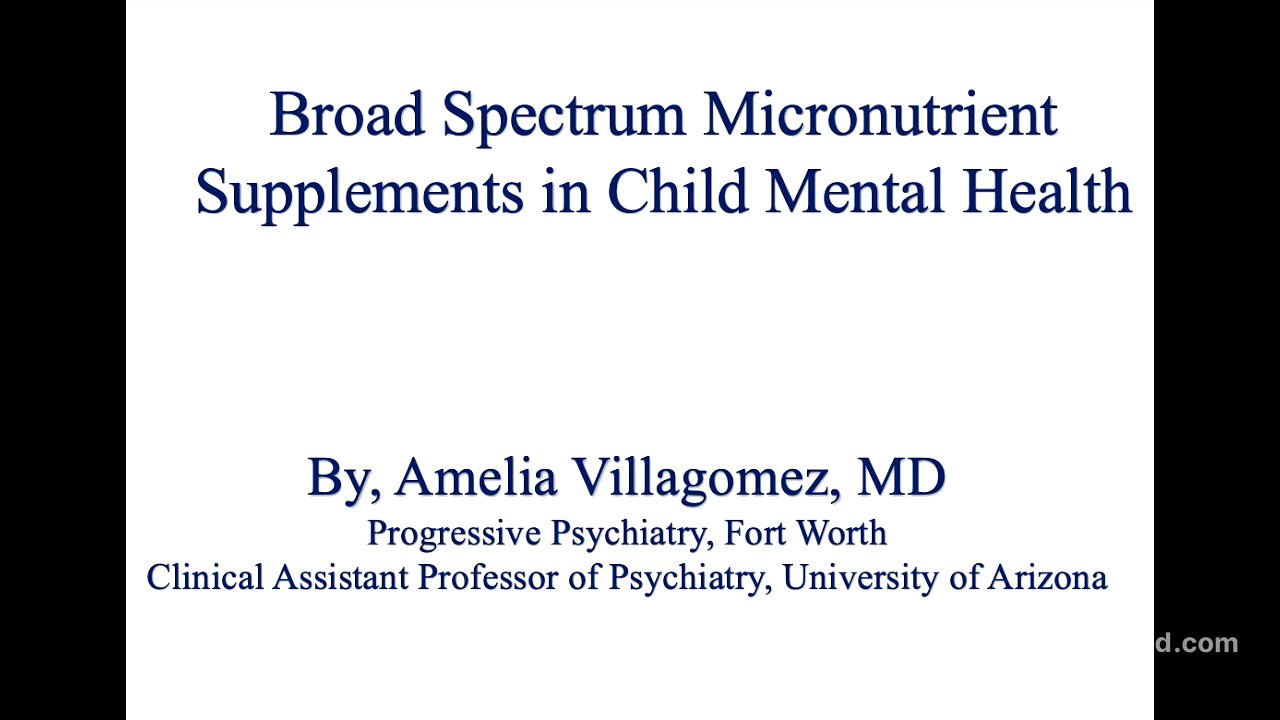TLDR;
This video features Dr. Bo Gomez discussing the use of broad-spectrum micronutrients for child mental health, particularly for mood dysregulation and ADHD. She highlights the importance of nutrition, the limitations of single-nutrient studies, and the benefits of broad-spectrum approaches. The discussion covers practical aspects such as dosage, cost, and potential medication interactions, as well as strategies for improving insurance coverage for necessary lab tests.
- Broad-spectrum micronutrients can significantly improve mood dysregulation, attention, and hyperactivity in children, especially those with ADHD.
- Chelated micronutrients enhance absorption and are more effective than patching together individual supplements.
- Addressing the gut microbiome is crucial for nutrient absorption and overall health.
Introduction [0:07]
Dr. Bo Gomez shares her expertise on broad-spectrum micronutrients, emphasizing their strong evidence base and effectiveness in addressing child mental health issues. She finds them relatively easy to understand and regularly discusses their use with pediatricians, highlighting the rationale behind this treatment approach.
The Importance of Nutrition [0:53]
The discussion emphasizes that modern diets, especially among teens and children, often lack essential nutrients. Studies show a direct, bi-directional correlation between poor nutrition and poor mental health. While advocating for healthy eating 80% of the time, Dr. Gomez cautions against overly restrictive diets that can lead to eating disorders like orthorexia. She notes that even individuals with reasonably good diets may benefit from micronutrients due to the reduced mineral and vitamin content in today's fruits and vegetables, a result of modern agricultural practices.
Benefits of Broad-Spectrum Micronutrients [3:38]
The review article highlights that studies focusing on single micronutrients often show small effect sizes, whereas broad-spectrum micronutrient studies typically demonstrate moderate effect sizes. This is because providing a variety of minerals and vitamins allows the body to utilize what it needs. Dr. Gomez primarily uses micronutrients for children with mood dysregulation, commonly seen in those with ADHD. Clinical experience and research indicate significant improvements in mood dysregulation, attention, focus, and hyperactivity in 60-80% of cases.
Research and Studies [5:06]
Initial open-label studies showed improvement with micronutrients, followed by double-blind, placebo-controlled trials confirming these benefits in children. A second double-blind, placebo-controlled trial also demonstrated similar improvements in mood dysregulation in children. Additionally, a study in adults with ADHD showed improvement in ADHD symptoms. These studies also found that broad-spectrum micronutrients increased the diversity of gut bacteria over 10 weeks, a result not seen in the placebo group.
Adverse Effects and Contraindications [7:12]
Most children tolerate micronutrients well, but medication-nutrient interactions can occur, potentially potentiating the effects of medications. Skill is required to manage these interactions. Adverse effects are minimal in monotherapy with micronutrients. Specific contraindications are detailed in an article by Charles Popper. Broad-spectrum micronutrients are gaining acceptance, with increasing press coverage and ongoing research.
Company Recommendations and Pricing [9:30]
Dr. Gomez has no financial interest in any micronutrient companies. She recommends both Truehope and DEN, but most parents prefer Truehope due to its twice-daily dosage. The ADHD study was conducted using the DEN product. A bottle of 120 capsules costs around $49.95, with psychiatrists able to create accounts that offer patients a 20-30% discount.
Usage with Stimulants and Dosage Adjustments [12:14]
Dr. Gomez uses micronutrients for both children who tolerate stimulants and those who do not. For children already on stimulants, she starts micronutrients and gradually reduces the stimulant dose by about half. This cross-titration must be done carefully to avoid adverse effects. The goal is to improve mood, reduce medication needs, and promote better eating habits.
Practical Tips for Administration [14:19]
To help children take the pills, capsules can be opened and mixed with yogurt or applesauce, which masks the taste effectively. Micronutrients support ADHD and mood dysregulation but do not resolve family dynamic issues. Over time, the dosage can be decreased, especially if the child's diet improves.
Patching vs. Broad-Spectrum [15:50]
Dr. Gomez has not found success with patients patching together individual supplements like B-complex, magnesium, and zinc. The key difference lies in the chelation of broad-spectrum micronutrients, which significantly affects absorption. Over-the-counter supplements may not be absorbed as effectively.
Micronutrients and Autism Spectrum Disorder [17:06]
Children on the autism spectrum are often highly sensitive to medication and micronutrient dosages. Small changes in dosage can have significant effects, requiring careful monitoring and adjustment.
Education and Administration [18:02]
It's crucial to educate parents that broad-spectrum micronutrients are not the same as simple vitamins and should be administered judiciously. Like medication, they have risks, benefits, and alternatives. Dr. Gomez provides a handout with TED talks and detailed information to ensure parents understand the potential effectiveness and the need for careful administration.
Insurance Coverage and Cost [19:19]
Unfortunately, insurance companies typically do not reimburse for micronutrients, although patients can use HSA cards. New Zealand's government supports these supplements as part of their insurance plans, but the U.S. does not. The duration of treatment depends on the individual's microbiome health. Some children respond quickly, while others may take several weeks to show improvement.
Integrative Psychiatry in Residency Programs [20:50]
The discussion opens up to questions about integrating psychiatry into residency programs, with offers of resources and curriculum-related comments.
Additional Resources and Coding for Labs [21:43]
Participants share free resources for self-care and integrative medicine. Coding diagnoses to align with ordered labs is crucial for insurance coverage. Adding codes for chronic pain, abdominal pain, nausea, dizziness, diabetes, autoimmune disorders, or headaches can increase the likelihood of coverage. Advocacy is needed to demonstrate the impact of micronutrient deficiencies on mental health.
Medicaid and Adopted Children [26:22]
Medicaid may be more lenient on covering labs for children at risk of malnutrition or lead poisoning. For adopted children with unknown genetic backgrounds, arguing for coverage based on potential inherited genetic defects can be effective. Coding for conditions like Pica can also justify lead testing.









